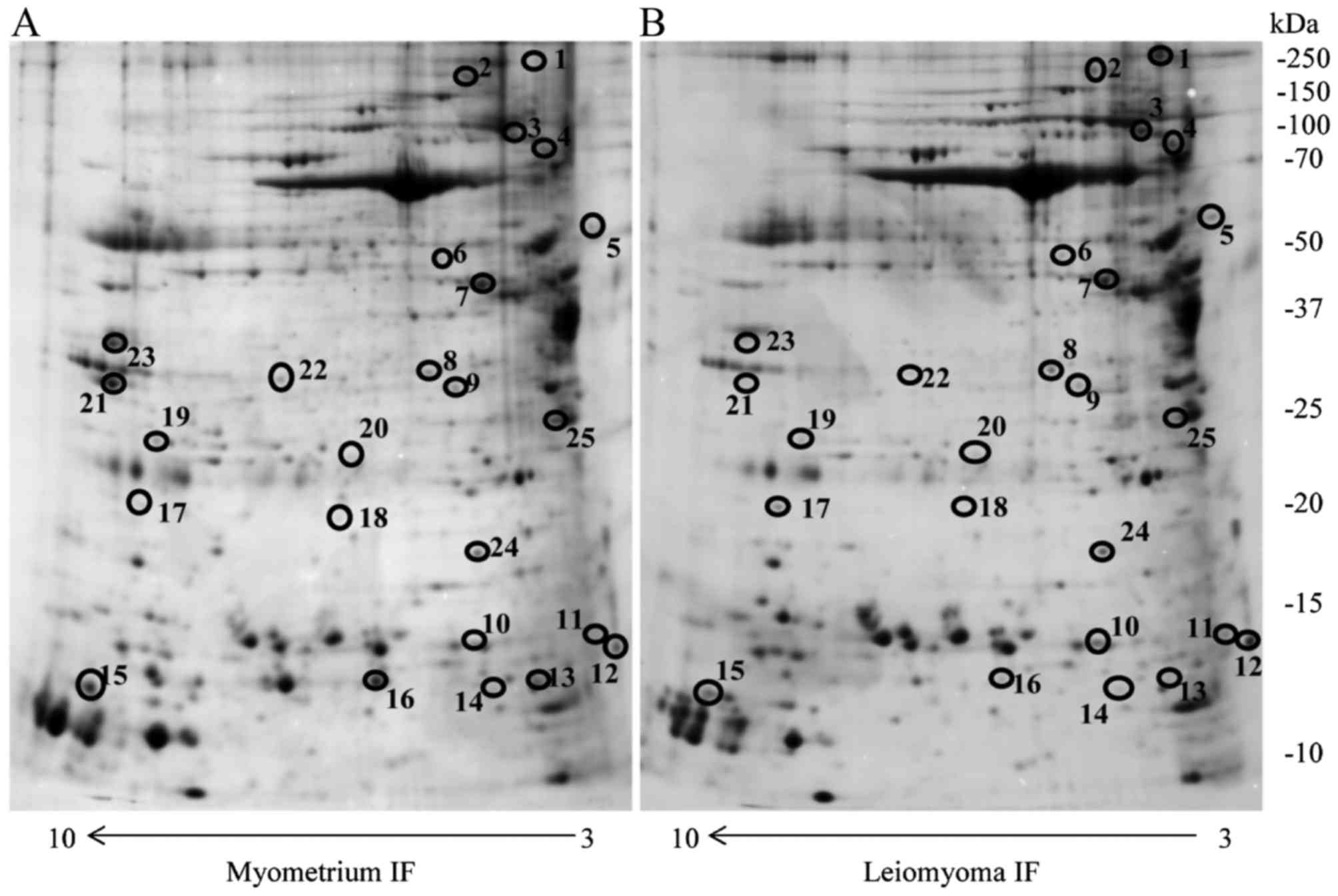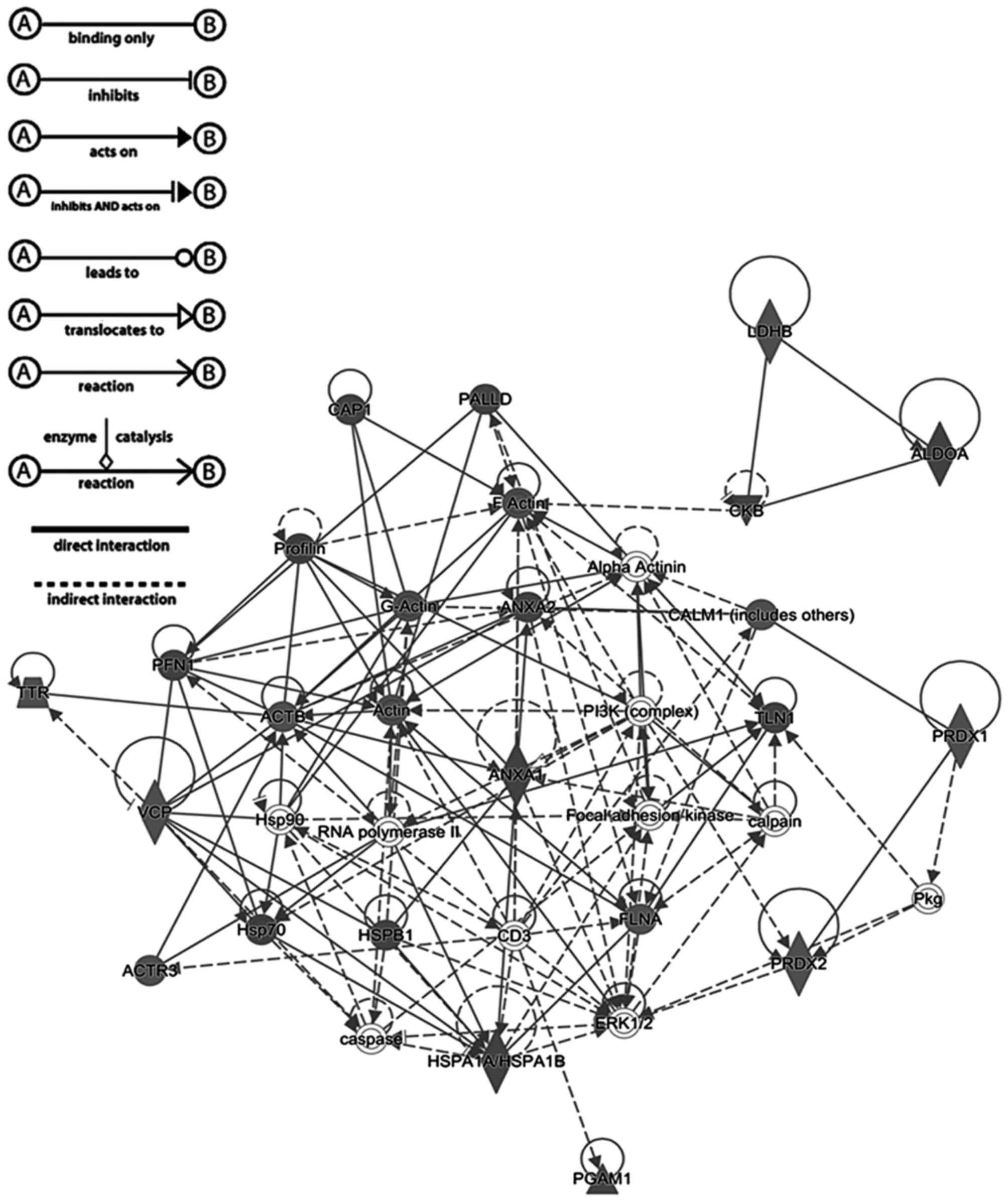|
1
|
Hashimoto K, Azuma C, Kamiura S, Kimura T,
Nobunaga T, Kanai T, Sawada M, Noguchi S and Saji F: Clonal
determination of uterine leiomyomas by analyzing differential
inactivation of the X-chromosome-linked phosphoglycerokinase gene.
Gynecol Obstet Invest. 40:204–208. 1995. View Article : Google Scholar : PubMed/NCBI
|
|
2
|
Haney AF: Clinical decision making
regarding leiomyomata: What we need in the next millennium. Environ
Health Perspect. 108:(Suppl 5). S835–S839. 2000. View Article : Google Scholar
|
|
3
|
Borahay MA, Al-Hendy A, Kilic GS and
Boehning D: Signaling pathways in leiomyoma: Understanding
pathobiology and implications for therapy. Mol Med. 21:242–256.
2015. View Article : Google Scholar : PubMed/NCBI
|
|
4
|
Catherino WH and Malik M: Uterine
leiomyomas express a molecular pattern that lowers retinoic acid
exposure. Fertil Steril. 87:1388–1398. 2007. View Article : Google Scholar : PubMed/NCBI
|
|
5
|
Arslan AA, Gold LI, Mittal K, Suen TC,
Belitskaya-Levy I, Tang MS and Toniolo P: Gene expression studies
provide clues to the pathogenesis of uterine leiomyoma: New
evidence and a systematic review. Hum Reprod. 20:852–863. 2005.
View Article : Google Scholar : PubMed/NCBI
|
|
6
|
Malik M and Catherino WH: Novel method to
characterize primary cultures of leiomyoma and myometrium with the
use of confirmatory biomarker gene arrays. Fertil Steril.
87:1166–1172. 2007. View Article : Google Scholar : PubMed/NCBI
|
|
7
|
Gromov P, Gromova I, Olsen CJ,
Timmermans-Wielenga V, Talman ML, Serizawa RR and Moreira JM: Tumor
interstitial fluid-a treasure trove of cancer biomarkers. Biochim
Biophys Acta. 1834:2259–2270. 2103. View Article : Google Scholar
|
|
8
|
Spano D and Zollo M: Tumor
microenvironment: A main actor in the metastasis process. Clin Exp
Metastasis. 29:381–395. 2012. View Article : Google Scholar : PubMed/NCBI
|
|
9
|
Norian JM, Owen CM, Taboas J, Korecki C,
Tuan R, Malik M, Catherino WH and Segars JH: Characterization of
tissue biomechanics and mechanical signaling in uterine leiomyoma.
Matrix Biol. 31:57–65. 2012. View Article : Google Scholar : PubMed/NCBI
|
|
10
|
Lv J, Zhu X, Dong K, Lin Y, Hu Y and Zhu
C: Reduced expression of 14-3-3 gamma in uterine leiomyoma as
identified by proteomics. Fertil Steril. 90:1892–1898. 2008.
View Article : Google Scholar : PubMed/NCBI
|
|
11
|
Lemeer S, Gholami AM, Wu Z and Kuster B:
Quantitative proteome profiling of human myoma and myometrium
tissue reveals kinase expression signatures with potential for
therapeutic intervention. Proteomics. 15:356–364. 2015. View Article : Google Scholar : PubMed/NCBI
|
|
12
|
Ura B, Scrimin F, Arrigoni G, Franchin C,
Monasta L and Ricci G: A proteomic approach for the identification
of up-regulated proteins involved in the metabolic process of the
leiomyoma. Int J Mol Sci. 17:5402016. View Article : Google Scholar : PubMed/NCBI
|
|
13
|
Ura B, Scrimin F, Arrigoni G, Athanasakis
E, Aloisio M, Monasta L and Ricci G: Abnormal expression of
leiomyoma cytoskeletal proteins involved in cell migration. Oncol
Rep. 35:3094–3100. 2016.PubMed/NCBI
|
|
14
|
Ura B, Scrimin F, Zanconati F, Arrigoni G,
Monasta L, Romano A, Banco R, Zweyer M, Milani D and Ricci G:
Two-dimensional gel electrophoresis analysis of the leiomyoma
interstitial fluid reveals altered protein expression with a
possible involvement in pathogenesis. Oncol Rep. 33:2219–2226.
2015.PubMed/NCBI
|
|
15
|
Gromov P, Gromova I, Bunkenborg J, Cabezon
T, Moreira JM, Timmermans-Wielenga V, Roepstorff P, Rank F and
Celis JE: Up-regulated proteins in the fluid bathing the tumour
cell microenvironment as potential serological markers for early
detection of cancer of the breast. Mol Oncol. 4:65–89. 2010.
View Article : Google Scholar : PubMed/NCBI
|
|
16
|
Mischiati C, Ura B, Roncoroni L, Elli L,
Cervellati C, Squerzanti M, Conte D, Doneda L, de Polverino Laureto
P, de Franceschi G, et al: Changes in protein expression in two
cholangiocarcinoma cell lines undergoing formation of multicellular
tumor spheroids in vitro. PLoS One. 10:e01189062015. View Article : Google Scholar : PubMed/NCBI
|
|
17
|
Li S and McLachlan JA: Estrogen-associated
genes in uterine leiomyoma. Ann N Y Acad Sci. 948:112–120. 2001.
View Article : Google Scholar : PubMed/NCBI
|
|
18
|
Desiniotis A and Kyprianou N: Significance
of talin in cancer progression and metastasis. Int Rev Cell Mol
Biol. 289:117–147. 2011. View Article : Google Scholar : PubMed/NCBI
|
|
19
|
Vandewynckel YP, Laukens D, Geerts A,
Bogaerts E, Paridaens A, Verhelst X, Janssens S, Heindryckx F and
Van Vlierberghe H: The paradox of the unfolded protein response in
cancer. Anticancer Res. 33:4683–4694. 2013.PubMed/NCBI
|
|
20
|
Totary-Jain H, Naveh-Many T, Riahi Y,
Kaiser N, Eckel J and Sasson S: Calreticulin destabilizes glucose
transporter-1 mRNA in vascular endothelial and smooth muscle cells
under high-glucose conditions. Circ Res. 97:1001–1008. 2005.
View Article : Google Scholar : PubMed/NCBI
|
|
21
|
Tarr JM, Young PJ, Morse R, Shaw DJ, Haigh
R, Petrov PG, Johnson SJ, Winyard PG and Eggleton P: A mechanism of
release of calreticulin from cells during apoptosis. J Mol Biol.
401:799–812. 2010. View Article : Google Scholar : PubMed/NCBI
|
|
22
|
Cauwe B, Martens E, Van den Steen PE,
Proost P, Van Aelst I, Blockmans D and Opdenakker G: Adenylyl
cyclase-associated protein-1/CAP1 as a biological target substrate
of gelatinase B/MMP-9. Exp Cell Res. 314:2739–2749. 2008.
View Article : Google Scholar : PubMed/NCBI
|
|
23
|
Plewka A, Madej P, Plewka D, Kowalczyk A,
Miskiewicz A, Wittek P, Leks T and Bilski R: Immunohistochemical
localization of selected pro-inflammatory factors in uterine myomas
and myometrium in women of various ages. Folia Histochem Cytobiol.
51:73–83. 2013. View Article : Google Scholar : PubMed/NCBI
|
|
24
|
Mullen L, Hanschmann EM, Lillig CH,
Herzenberg LA and Ghezzi P: Cysteine oxidation targets
peroxiredoxins 1 and 2 for exosomal release through a novel
mechanism of redox-dependent secretion. Mol Med. 13:98–108.
2015.
|
|
25
|
Kubota D, Mukaihara K, Yoshida A, Tsuda H,
Kawai A and Kondo T: Proteomics study of open biopsy samples
identifies peroxiredoxin 2 as a predictive biomarker of response to
induction chemotherapy in osteosarcoma. J Proteomics. 91:393–404.
2013. View Article : Google Scholar : PubMed/NCBI
|
|
26
|
Aström A, Pettersson U and Voorhees JJ:
Structure of the human cellular retinoic acid-binding protein II
gene. Early transcriptional regulation by retinoic acid. J Biol
Chem. 267:25251–25255. 1992.PubMed/NCBI
|
|
27
|
Zaitseva M, Vollenhoven BJ and Rogers PA:
Retinoic acid pathway genes show significantly altered expression
in uterine fibroids when compared with normal myometrium. Mol Hum
Reprod. 13:577–585. 2007. View Article : Google Scholar : PubMed/NCBI
|
|
28
|
Capello M, Ferri-Borgogno S, Cappello P
and Novelli F: α-Enolase: A promising therapeutic and diagnostic
tumor target. FEBS J. 278:1064–1074. 2011. View Article : Google Scholar : PubMed/NCBI
|
|
29
|
Valapala M, Maji S, Borejdo J and
Vishwanatha JK: Cell surface translocation of annexin A2
facilitates glutamate-induced extracellular proteolysis. J Biol
Chem. 289:15915–15926. 2014. View Article : Google Scholar : PubMed/NCBI
|
|
30
|
Hageman J, Vos MJ, van Waarde MA and
Kampinga HH: Comparison of intra-organellar chaperone capacity for
dealing with stress-induced protein unfolding. J Biol Chem.
282:34334–34345. 2007. View Article : Google Scholar : PubMed/NCBI
|
|
31
|
Chen Z, Barbi J, Bu S, Yang HY, Li Z, Gao
Y, Jinasena D, Fu J, Lin F, Chen C, et al: The ubiquitin ligase
Stub1 negatively modulates regulatory T cell suppressive activity
by promoting degradation of the transcription factor Foxp3.
Immunity. 39:272–285. 2013. View Article : Google Scholar : PubMed/NCBI
|
|
32
|
Mambula SS, Stevenson MA, Ogawa K and
Calderwood SK: Mechanisms for Hsp70 secretion: Crossing membranes
without a leader. Methods. 43:168–175. 2007. View Article : Google Scholar : PubMed/NCBI
|
|
33
|
Daniels GA, Sanchez-Perez L, Diaz RM,
Kottke T, Thompson J, Lai M, Gough M, Karim M, Bushell A and Chong
H: A simple method to cure established tumors by inflammatory
killing of normal cells. Nat Biotechnol. 22:1125–1132. 2004.
View Article : Google Scholar : PubMed/NCBI
|
|
34
|
Martin San S, Soto-Suazo M, De Oliveira
SF, Aplin JD, Abrahamsohn P and Zorn TM: Small leucine-rich
proteoglycans (SLRPs) in uterine tissues during pregnancy in mice.
Reproduction. 125:585–595. 2003. View Article : Google Scholar : PubMed/NCBI
|
|
35
|
Nikitovic D, Papoutsidakis A, Karamanos NK
and Tzanakakis GN: Lumican affects tumor cell functions, tumor-ECM
interactions, angiogenesis and inflammatory response. Matrix Biol.
35:206–214. 2014. View Article : Google Scholar : PubMed/NCBI
|
|
36
|
Lorenz K, Schmitt JP, Schmitteckert EM and
Lohse MJ: A new type of ERK1/2 autophosphorylation causes cardiac
hypertrophy. Nat Med. 15:75–83. 2009. View
Article : Google Scholar : PubMed/NCBI
|
|
37
|
Richard I, Broux O, Allamand V,
Fougerousse F, Chiannilkulchai N, Bourg N, Brenguier L, Devaud C,
Pasturaud P, Roudaut C, et al: Mutations in the proteolytic enzyme
calpain 3 cause limb-girdle muscular dystrophy type 2A. Cell.
81:27–40. 1995. View Article : Google Scholar : PubMed/NCBI
|












